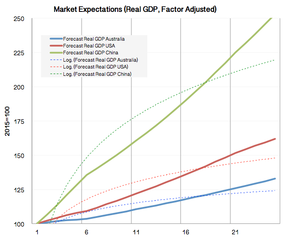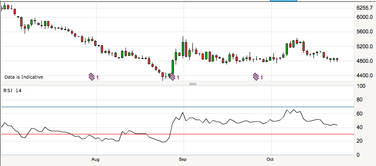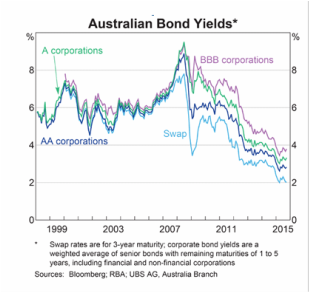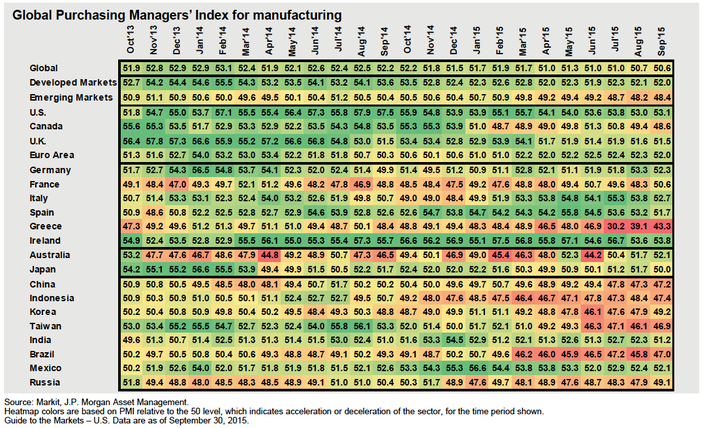Strategy Update - October 2015
Overview
The past few months have been dominated by market volatility, with investors growing increasingly anxious about whether a US economic recovery can sustain itself in the midst of a likely Fed rate hike later this year. This is a very real concern, after all we have China slowing who (as we saw on two occasions in August) are willing to pull their trump card; a trifecta of currency devaluation, fiscal stimulus and monetary loosening. But for now US is delivering some fairly decent economic data with relatively low inflation, which is good news for investors. Europe has also continued to strengthen, and while debt levels are still higher than we would like, relative to the US and Australia valuations appear fair.
Meanwhile Australia has been going the other way. Earnings growth remains lackluster, labour costs are high and margins are under pressure. While a weaker $AUD has helped dampen the decline in some sectors we still have a significant proportion of our eggs in the commodities basket, the consequence of which is further downward pressure on aggregate earnings. With further weakness in commodity prices expected, the $AUD is currently trading at US$0.72 and the yield on long-dated treasury Bonds has evaporated. Capital seems to have flowed into equity markets in what looks to be investors chasing returns while standing very close to the exit door.
In light of these conditions we have made a number of important changes to our investment strategy. For some investors these changes will be immaterial, however for others this may cause substantial shifts in portfolio allocations. A summary of personal recommendations will be provided over the next week.
The following is a summary of our key moves and motivations:
Meanwhile Australia has been going the other way. Earnings growth remains lackluster, labour costs are high and margins are under pressure. While a weaker $AUD has helped dampen the decline in some sectors we still have a significant proportion of our eggs in the commodities basket, the consequence of which is further downward pressure on aggregate earnings. With further weakness in commodity prices expected, the $AUD is currently trading at US$0.72 and the yield on long-dated treasury Bonds has evaporated. Capital seems to have flowed into equity markets in what looks to be investors chasing returns while standing very close to the exit door.
In light of these conditions we have made a number of important changes to our investment strategy. For some investors these changes will be immaterial, however for others this may cause substantial shifts in portfolio allocations. A summary of personal recommendations will be provided over the next week.
The following is a summary of our key moves and motivations:
Summary:
A further explanation is provided below:
- Global macro positioning – moving to slight underweight equities, neutral bonds and overweight cash (and short-term bullet bonds)
- Further reducing our exposure to Australia (from underweight to heavily underweight)
- Reducing our exposure to North America from overweight to neutral
- Increasing our currency hedging to 60% or more
- Slight increase in our exposure to Europe; roughly neutral relative to benchmark
- Increase exposure to China from underweight to slight overweight
- Commodities: overweight benchmark (in particular oil, however expect 5 -10 years for this strategy to play out)
- Fixed income markets: exit Australian corporate debt and reduce exposure to long-dated treasuries. Actively reduce portfolio duration, look to 3-5 year re-set on bullet-bonds.
- Australian residential property market still a concern and threat to economic stability and growth outlook.
A further explanation is provided below:
|
Macro Positioning - reduce equities, neutral bonds, overweight cash
|
Globally economic conditions are better than they have been for some time. Trend GDP is still soft, but has resumed to levels that restore our faith that forecasts of "GFC Mark II" are now dead in the water (of course some markets are weaker than others, but we will get to that later). Our expectation is for further wind-down of quantitative easing and increases in interest rates. While this increase in rates could be cause for concern among the less well-developed markets (particularly those still using QE who have large amounts of foreign debt), so long as inflation can keep pace with the rise in interest margin, we should hopefully avoid too much of a mess. In summary: things are better than they were (5 years ago), but they still aren't great. From a valuation perspective, it could be argued that developed market equities are now priced to reflect (a) slow-but-steady earnings growth with continued low interest rates, or (b) strong earnings growth with moderate increases in interest rates. This is a fairly logical way to think of market pricing, but it doesn't leave a lot of room for error. If we were to use the US as proxy for global markets, we would see signs pointing toward a moderate increase in rates combined with a generally slow upward trend in earnings growth. In this case the upside potential for US equities (and global equities in general) seems fairly limited. It's still there, but it's hardly compelling. Given where we have come from, valuations appear to be moderately overheated, and in response we are reducing our overall equities exposure from net neutral to slight underweight. In these conditions we could almost skip over commentating on Bond markets, except to say that I was wrong. If you remember, 2 - 3 years ago I was forecasting a stronger-than-expected recovery in US equities (and market consolidation), from which we made the strategic call to heavily overweight US equities and $USD while getting as far away from mid and long-dated Bond markets as we could. Well, two out of three ain't bad. The Bond "crash" never eventuated. Why? Well, probably something to do with the way that QE was spent. We didn't see the inflation I thought we would but we saw business spending (and credit) pick up, so here we are: without QE but still sitting on ZIRP. From here it seems that markets have had plenty of time to catch their breath, and Bonds in most markets now seem fairly priced. Finally, cash. For most investors the real return (i.e., return net inflation) is tracking between -1.0% and +0.5%. Some incremental value can be obtained through short-term bullet-bonds. We are overweight cash primarily as a means of risk management and liquidity. The drag on returns caused by our overweight exposure to cash can be justified by expectations of valuation anomalies in (select) equity markets. This cash will be re-delployed as conditions normalise (or move into "cheap" territory).
|
|
Reduce Australian equities from underweight to heavily underweight
|
For several years now we have been heavily underweight Australian equities as we believed equity pricing did not properly reflect risk and overestimated earnings growth. This was one of the reasons we took such a heavy tilt away from Australia and toward unhedged North American equities. More recently Australian equities have had more than their fair share of "bad luck", a large amount attributable to our saviours through the GFC: China. And it doesn't look like getting much better anytime soon. Household debt levels are at extraordinary levels, unemployment has began to tick upwards, and even the influx of cheap credit has not been enough to spur on inflation (or meaningful levels of credit growth even!). But now if you value the Australian share market you could be excused for thinking otherwise. Valuation premiums (equity risk premiums) are below trend while Price-to-Cash flow ratios are now roughly 30% above trend. By our estimates, the Australian equity market is overvalued by around 7%, but with potential downside risk in the order of 20% - 30% should we slide into recession. While there are opportunities within the Australian share market, the market as a whole does not offer sufficient return to justify the risk. Almost counter intuitively, the areas that we do see value in tend to be cyclicals (example: energy companies with very low debt).
|
|
Reduce North American equities
|
Considering the economic growth and interest rate outlook, North American equities now appear moderately expensive. It also looks like domestic production has outpaced demand, leading to a sharp increase in inventory levels (not at critical levels, but could still cause some discounting in the near term). Though as a whole the market is not necessarily overpriced (earnings still look good) we believe it's sensible to moderate our exposure to the region. For many investors this will result in a meaningful change to portfolios (as our overweight exposure to the region has been further exacerbated by strong returns in recent years). Long term we still like the region, so for investors with multi-decade investment horizons North American equities should still provide a core element of global equity portfolios.
|
|
Increase currency hedging
|
The Australian Dollar is currently trading at around USD$0.72. While the outlook for economic growth and interest rates (both in Australia and the US) will place further downward pressure on the dollar, on the balance of risk it appears that there is an equal if not greater level of risk that the Australian dollar could strengthen from this level. Currency markets appear to have factored in a reasonably pessimistic view of Australia already. From a strategic perspective our decision to apply currency hedging is to help absorb risk from our heavily underweight Australian equities portfolio: in other words, if our equities call is wrong and Australia's economic growth rebounds strongly, then some of the losses from not holding Australian equities should be absorbed through a strengthening $AUD. The counter of this is that we believe the $AUD is already priced with expectations of economic downturn in mind, thus meaning that if we are correct the premium received from a weaker $AUD will not fully reflect the weakening of the Australian economy. Besides, if the Australian economy does weaken, it is unlikely we will want to unwind our $USD exposures to invest locally, instead we would use local cash to increase our overall equities exposure. In some ways this is an "each ways bet", but on balance we believe it is the best way to manage risk.
|
|
Slight increase to European equities
|
As previously mentioned, European equities are currently trading at a slight discount to trend, with the UK, Germany and France trading roughly 5% - 10% below trend on a justified PE and book value basis. There is not yet sufficient evidence that the recent accelaeration in earnings growth isn't just a flow-on effect from the ECB's QE program (which is still running hot), as such we feel it's better to be cautiously optimistic and selective with our exposure to European equities.
|
|
Australian residential property market
|
There isn't much here that hasn't already been said. As I've written about on many occasions the Australian residential property market is (in aggregate) extremely overvalued, now trading with similar return characteristics to Treasury Indexed Bonds, but of course with much greater risk. Interestingly some talk of a "bubble" has made it through to mainstream media, but of course have been dismissed by property "experts" like real estate agents. We retain our "sell" recommendation over Australian residential property (at an asset-class level) and while we expect a correction in the mid-term (within the next 5 - 10 years) we don't expect it to be too dramatic; perhaps a 15% - 20% fall in prices before a protracted period of stagnation. Locally, Melbourne property prices would need to correct by roughly 35% (from current levels) to justify investment (relative to other opportunities). We reaffirm our sell rating and warn that sectors tied to the residential property market (and household credit growth) may have a tough few years ahead.
|



